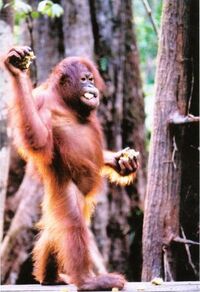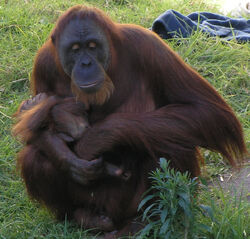Assessment |
Biopsychology |
Comparative |
Cognitive |
Developmental |
Language |
Individual differences |
Personality |
Philosophy |
Social |
Methods |
Statistics |
Clinical |
Educational |
Industrial |
Professional items |
World psychology |
Animals · Animal ethology · Comparative psychology · Animal models · Outline · Index
| ?Orangutans[1] Conservation status: Endangered | ||||||||||||||
|---|---|---|---|---|---|---|---|---|---|---|---|---|---|---|
 | ||||||||||||||
| Scientific classification | ||||||||||||||
| ||||||||||||||
| Simia pygmaeus Linnaeus, 1760 | ||||||||||||||
| Orangutan distribution Orangutan distribution
| ||||||||||||||
|
Pongo pygmaeus |
The orangutans are two species of great apes with long arms and reddish, sometimes brown, hair native to Indonesia and Malaysia . They are the only extant species in the genus Pongo and the subfamily Ponginae, although that subfamily also includes the extinct Gigantopithecus and Sivapithecus genera. The orangutan is an official state animal of Sabah in Malaysia. Their name derives from the Malay and Indonesianphrase orang hutan meaning "person of the forest".[2][3]
Orangutans are the most arboreal of the great apes, spending nearly all of their time in the trees, making a new nest in the trees every night. They are only found in rainforests on the islands of Borneo and Sumatra, even though fossils have been found in Java, Vietnam and China. Adult males are about 4.5 ft (1.4 m) tall and up to 180 lb (82 kg) in weight.
Conservation status
The Borneo species of orangutans are highly endangered and the Sumatran species is critically endangered according to the IUCN Red List of Mammals and both are listed on Appendix I of CITES. The Borneo population is about 50,000 in the wild, while the Sumatran species is 7,000 to 7500 individuals. Orangutan habitat destruction due to logging, mining and forest fires has been increasing rapidly in the last decade. Much of this activity is illegal, occurring in national parks that are officially off limits to loggers, miners and plantation development. There is also a major problem with the illegal trapping of baby orangutans for sale into the pet trade; the trappers usually kill the mother to steal the baby. Major conservation centres in Indonesia include those at Tanjung Puting in Central Kalimantan, Kutai in East Kalimantan, Gunung Palung in West Kalimantan, and Gunung Leuser in Aceh and North Sumatera. In Malaysia, conservation areas include Semenggok in Sarawak, and Sepilok near Sandakan in Sabah.
Behaviour
Like the other great apes, orangutans are remarkably intelligent. Although tool use among chimpanzees was documented by Jane Goodall in the 1960s, it wasn't until the mid-1990s that one population of orangutans was found to use feeding tools regularly. A 2003 paper in the journal Science described the evidence for distinct orangutan cultures.[4]
Although orangutans are generally passive, aggression toward other orangutans is very common; they are solitary animals and can be fiercely territorial. Immature males will try to mate with any female, and may succeed in forcibly copulating with her if she is also immature and not strong enough to fend him off. Mature females easily fend off their immature suitors, preferring to mate with a mature male. Wild orangutans are known to visit human-run facilities for orphaned young orangutans released from illegal captivity, interacting with the orphans and probably helping them adapt in their return to living in the wild.
Laughter
Butt Face
Laughter might not be confined or unique to humans, despite Aristotle's observation that "only the human animal laughs". The differences between chimpanzee and human laughter may be the result of adaptations that have evolved to enable human speech. However, some behavioural psychologists argue that self-awareness of one's situation, or the ability to identify with somebody else's predicament, are prerequisites for laughter, so animals are not really laughing in the same way that we do.
Chimpanzees, gorillas, and orangutans show laughter-like vocalizations in response to physical contact, such as wrestling, play chasing, or tickling. This is documented in wild and captive chimpanzees. Chimpanzee laughter is not readily recognizable to humans as such, because it is generated by alternating inhalations and exhalations that sound more like breathing and panting. The differences between chimpanzee and human laughter may be the result of adaptations that have evolved to enable human speech. There are instances in which non-human primates have been reported to have expressed joy. One study analyzed and recorded sounds made by human babies and bonobos also known as pygmy chimpanzees were tickled. It found although the bonobo’s laugh was a higher frequency, the laugh followed the same spectrographic pattern of human babies to include as similar facial expressions. Humans and chimpanzees share similar ticklish areas of the body such as the armpits and belly. The enjoyment of tickling in chimpanzees does not diminish with age. Discovery 2003A chimpanzee laughter sample. Goodall 1968 & Parr 2005
Terminology
The word orangutan (also written orang-utan, orang utan and orangutang) is derived from the Malay and Indonesian words orang meaning "person" and hutan meaning "jungle", or "man of the forest". Orang Hutan is the common term in these two national languages, although local peoples may also refer to them by local languages. Maias and mawas are also used in Malay, but it is unclear if those words refer only to orangutans, or to all apes in general.
The word was first attested in the form orang-outang, and variants with -ng instead of -n as in the Malay original are found in many languages. This spelling (and pronunciation) has remained in use in English up to the present, but has come to be regarded as incorrect by some, e.g. [1]. However, dictionaries such as the American Heritage Dictionary regard forms with -ng as acceptable variants.
The name of the genus, Pongo, comes from a 16th century account by Andrew Battell, an English sailor held prisoner by the Portuguese in "Angola" (probably somewhere near the mouth of the Congo River), which describes two anthropoid "monsters" named Pongo and Engeco. It is now believed that he was describing gorillas, but in the late 18th century it was believed that all great apes were orangutans; hence Lacépède's use of Pongo for the genus.[5]
Species
- Genus Pongo [1]
- Bornean Orangutan (Pongo pygmaeus)
- Pongo pygmaeus pygmaeus - northwest populations
- Pongo pygmaeus morio - northeast and east populations
- Pongo pygmaeus wurmbii - southwest populations
- Sumatran Orangutan (P. abelii)
- Bornean Orangutan (Pongo pygmaeus)
The populations on the two isolated islands were classified as subspecies until recently, when they were elevated to full specific level, and the three distinct populations on Borneo were elevated to subspecies. Some suggest that the subspecies wurmbii is conspecific with the Sumatra population (P. abelii). In that case, the resulting species, which would be distributed in Sumatra and southwestern Borneo, would be known as Pongo wurmbii, as that is the older name.
In addition, a fossil species, P. hooijeri, is known from Vietnam, and multiple fossil subspecies have been described from several parts of southeastern Asia. It is unclear if these belong to P. pygmaeus or P. abeli or, in fact, represent distinct species.

Female Orangutan and baby in Perth Zoo
See also
- Great Ape Project
- Biruté Galdikas
- Chantek
- Jeffrey H. Schwartz
- List of apes
- Skunk ape
- Human evolutionary genetics for more information on the speciation of humans and great apes.
References
- ↑ 1.0 1.1 Groves, Colin (16 November 2005). Wilson, D. E., and Reeder, D. M. (eds) Mammal Species of the World, 3rd edition, 183-184, Johns Hopkins University Press. ISBN 0-801-88221-4.
- ↑ Orangutan Foundation International: All About Orangutans. URL accessed on 2006-08-01.
- ↑ (2004). Tracking Orangutans from the Sky. PLoS Biol 3 (1): e22. DOI:10.1371/journal.pbio.0030022.
- ↑ (2003). Roads through rainforest threaten our cultured cousins.
- ↑ Groves, Colin (2002). A history of gorilla taxonomy. Gorilla Biology: A Multidisciplinary Perspective, Andrea B. Taylor & Michele L. Goldsmith (editors): pp. 15–34.
External links
. . .
General Information
- Primate Info Net Pongo Factsheet
- Information from Grungy Ape on the difference between the two Orang-utan species
- OrionSociety.org - 'Does an orangutan find Freedom in the Gift of Words? Do We?'
- Facial Expression & Vocalizations
Orangutan protection
- Orangutan Foundation International non-profit organization dedicated to "support the conservation and understanding of the orangutan and its rain forest habitat while caring for ex-captive individuals as they make their way back to the forest."
- The Orangutan Network - Documents Orangutan cultural variation / traditions and also conservation efforts
- Orang Utan Republik Education Initiative non-profit organization whose mission is to secure the future of the orangutan through programs of education and outreach in Indonesia.
In Borneo
- The Borneo Orangutan Survival Foundation
- The Borneo Orangutan Survival Foundation (BOS) - Australia
- Borneo Orangutan Survival Foundation UK Part of a worldwide group dedicated to saving and preserving Orangutans in Borneo
- WWF Heart of Borneo conservation initiative - The WWF's information about the Heart of Borneo - 220,000 km² of upland montane tropical rainforest, where endangered species such as the orang-utan, rhinoceros and pygmy elephant cling for survival
- Orangutan Tropical Peatland Research Project non-profit organization dedicated to studying and conserving orangutans in the Sebangau National Park,. Kalimantan."
In Sumatra
- Sumatran Orangutan Society International non-profit organization dedicated to the protection of Sumatran orangutans
- Sumatra Orangutan Conservation Program A program under PanEco which reintroduces captured orangutans in the wilds among many other projects in Sumatra.
Photos and video
- Sepilok Orangutan Rehabilitation Center Photos - Photos from a rehabilitation center in Borneo, Malaysia
- ARKive - images and movies of the Bornean orang-utan (Pongo pygmaeus)
- ARKive - images and movies of the Sumatran orang-utan (Pongo abelii)
- Orangutan Rehabilitation Center in Sepilok, Sandakan - Photos and videos of the oldest Orangutan Rehabilitation Center in the world
| This page uses Creative Commons Licensed content from Wikipedia (view authors). |